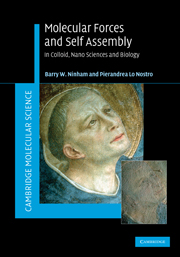Book contents
- Frontmatter
- Contents
- Preface
- Part I Molecular forces
- 1 Reasons for the enquiry
- 2 Different approaches to, and different kinds of, molecular forces
- 3 Electrostatic forces in electrolytes in outline
- 4 The balance of forces
- 5 Quantum mechanical forces in condensed media
- 6 The extension of the Lifshitz theory to include electrolytes and Hofmeister effects
- 7 Specific ion effects
- 8 Effects of dissolved gas and other solutes on hydrophobic interactions
- Part II Self assembly
- Index
- References
4 - The balance of forces
from Part I - Molecular forces
Published online by Cambridge University Press: 06 January 2011
- Frontmatter
- Contents
- Preface
- Part I Molecular forces
- 1 Reasons for the enquiry
- 2 Different approaches to, and different kinds of, molecular forces
- 3 Electrostatic forces in electrolytes in outline
- 4 The balance of forces
- 5 Quantum mechanical forces in condensed media
- 6 The extension of the Lifshitz theory to include electrolytes and Hofmeister effects
- 7 Specific ion effects
- 8 Effects of dissolved gas and other solutes on hydrophobic interactions
- Part II Self assembly
- Index
- References
Summary
Forces in the DLVO theory of colloidal stability
For over 50 years the theory of the stability of colloid suspensions due independently to Deryaguin and Landau and Verwey and Overbeek held centre stage in the field. Following the derivation from quantum mechanics of the attractive force between two molecules, it was a straightforward matter to add these forces up to arrive at a force between two model colloidal particles. This potential of interaction per unit area behaves, for two particles modelled as planar interfaces a distance l apart as, V(l) ≈ −A/(12πl2) where A is the Hamaker constant (see Chapter 2).
The double-layer force of repulsion between the (charged) surfaces behaves at large distances of separation as V(l) ≈ f · exp(−κDl). Here κD is the Debye length, which depends on salt concentration, and the prefactor is a complicated function of the surface charge or potential (see Chapter 3). Then a combination of these forces gives rise to a predicted net force of attraction like that shown schematically in Fig. 4.1.
These forces depend on geometry assumed for the particles (see Chapter 2). The insertion of this potential into a theory of coagulation of particles predicted whether the particles would stay in suspension or flocculate. The particles could flocculate into a ‘secondary minimum’, with a barrier usually at l ∼ 1/κD.
Or in the absence of such a barrier they could (theoretically) adhere into a deep ‘primary’ minimum at a distance of a few molecular diameters.
- Type
- Chapter
- Information
- Molecular Forces and Self AssemblyIn Colloid, Nano Sciences and Biology, pp. 65 - 83Publisher: Cambridge University PressPrint publication year: 2010



